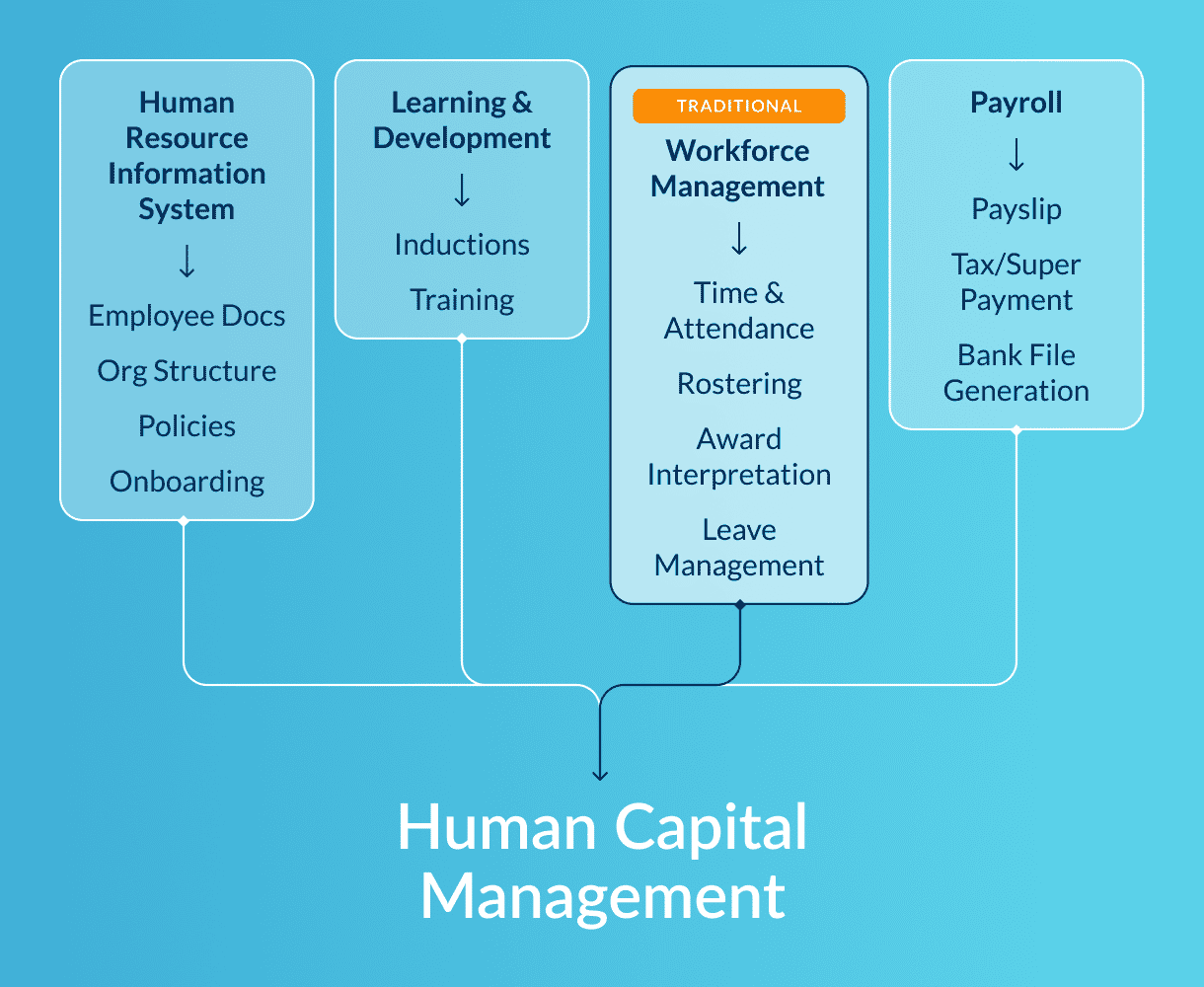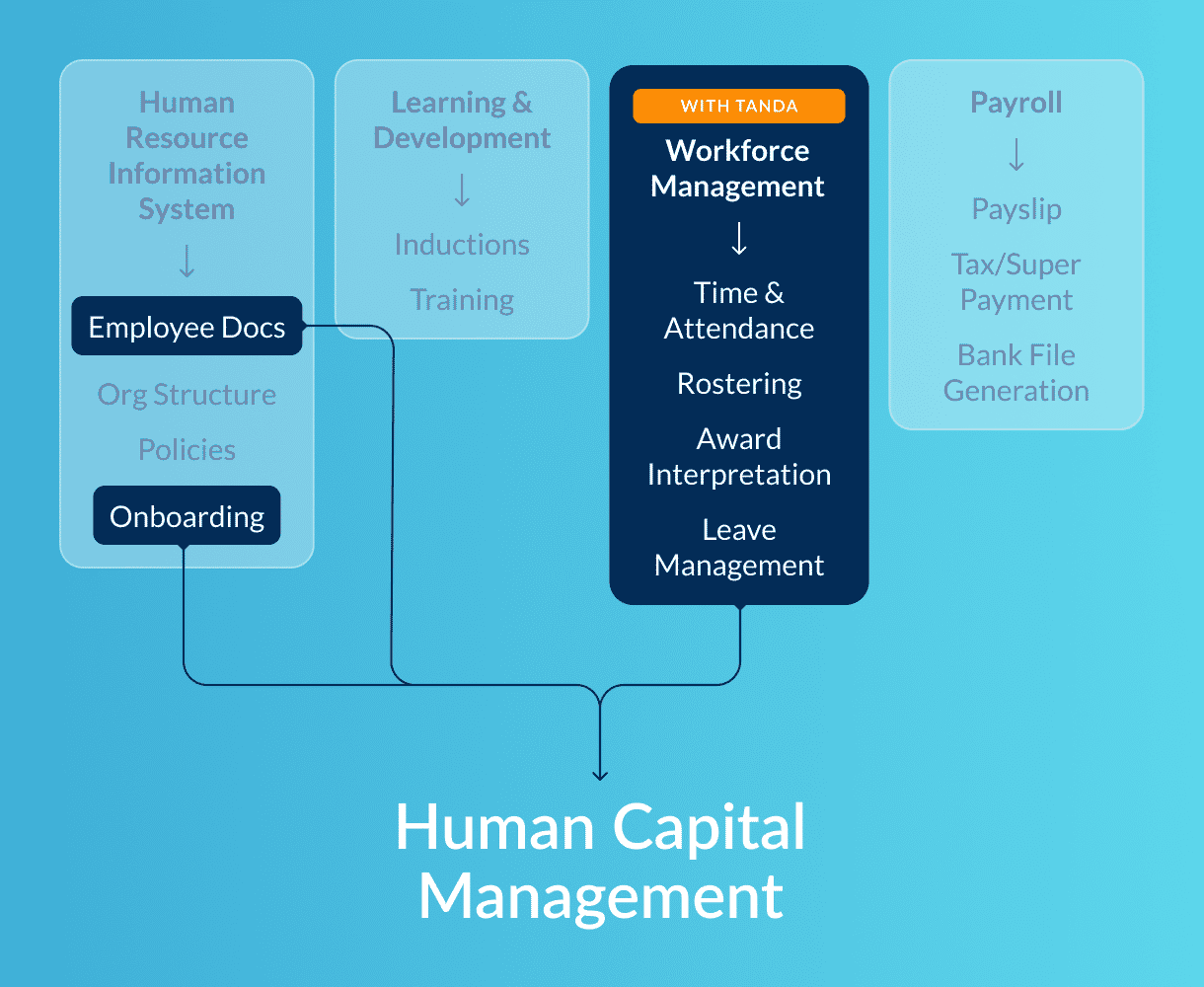The business world is full of jargon and cliches that can be difficult to understand. Add in a sea of acronyms, and it can be easy to get lost in translation when you’re looking for simple answers for how to manage basic tasks.
Workforce Management may sound like a buzzword, but it’s actually pretty important. In essence, Workforce Management is the art of getting your employees to work in the most efficient way possible to maximise productivity while following the law. There are four key tenets: Time & Attendance, Rostering, Award Interpretation, and Leave Management.
But, what about other parts of Human Resources, like payroll, and onboarding? They’re still in the overall picture, but aren’t quite part of “Workforce Management”. Check out the diagram below to help you understand where everything fits.

If you look at the list of tenets under Workforce Management, you might think, okay, it’s probably a little bit of work, but I might be able to handle these manually. For a long time, that’s exactly what people did. Businesses used to manually record time and attendance and look up individual pay rates online. Rosters were drawn up by looking at sales data in excel, or even just based off the vibe of things.
Workforce Management Software has changed the way businesses manage each of these processes. Of course, coverage varies – some software will look to cover all four of the tenets in the above diagram. Others cover just one. Tanda has a slight mix, covering all of Workforce Management, as well as employee documentation and onboarding.

Key Aspects of Workforce Management
Time and Attendance
It’s a key requirement that every business accurately records employee time and attendance. This is the basis for payroll and complying with Australian workplace law. The process sounds straightforward – record the hours employees work, plug them into payroll, and pay the worker. The reality is paper based timesheets need to be entered into payroll manually, which has often led to errors, and workers being underpaid. They also need to be kept on file for seven years. Fair Work has been cracking down on businesses underpaying their staff, launching surprise audits. The Ombudsman is ruthless, and businesses have been fined millions of dollars for non-compliance.
Workforce Management Software has been game changing for time and attendance. Modern systems use digital time clocks capable of recording the exact time employees work.
Employees enter a unique code to clock in and out. The system takes a photo proving it was the employee. This data can then be plugged straight into payroll to accurately pay employees. Cloud-based systems can then keep payroll records for the required seven years. This makes dealing with a Fair Work audit simple and easy.
Rostering
Rostering is arguably the most important part of Workforce Management. Getting rosters right is crucial to the operations of any business. This is complex, because rosters are based off all sorts of different factors, like sales data, worker qualifications, managers and leave. Add in compliance risks like visa conditions and rostering can easily turn into a disaster. Employees also need to be kept aware of the roster and any changes that are made. Communicating shifts and changes can be a lot of work.
Workforce Management Software can simplify this process. By plugging into point of sale systems, Tanda can help you make data-diven decisions that optimise rosters. Creating, modifying and distributing rosters is intuitive and simple. Using data also allows sophisticated reports to be created outlining costs, staffing and other core business metrics. Likewise, managing employees is simple with the Tanda mobile app. Instead of spending hours texting or on the phone, employees can be notified and accept shifts via the app.
Shift Swapping
Tanda also has the ability approve shift swaps with complete oversight of costs and compliance. Managers can offer the shift to all available staff or to select employees. Tanda will also notify you if offering an employee an extra shift will require you to pay overtime.
Award Interpretation
Australia has unique workplace laws that make workforce management and payroll complicated. “Awards” set the pay and conditions for millions of workers in Australia’s most common industries. Awards are designed to give workers a fair go without making businesses unprofitable, and the pay rates are updated every year. The problem is that there are 122 Modern Awards, and each of them contain hundreds of pay rules. This hidden complexity means you need to read an encyclopedia worth of information just to be able to pay a few of your employees. Manually updating each of the rules is also incredibly time consuming.
But you can’t just ignore Awards. Failing to comply with all the rules will expose you to major fines from Fair Work. Workforce Management Software is a great way to combat this problem. Tanda’s Award interpreter has comprehensive coverage of a large number of modern awards, right down to the letter. Base rates, overtime, allowances, higher duties and other industrial instruments are all covered. Tanda manages these interpretations before exporting straight to your integrated payroll system. Running a digital system reduces complicated calculations and gives you certainty that you’re paying staff correctly.
Leave Management
Managing your employees annual leave and sick leave has always a major part of Workforce Management. Every business wants to make sure they’re not understaffed, and have a good overview of exactly when employees are taking leave. Just as important is makign sure people don’t take leave in crucial periods for the business.
Tanda can give you a heads up view that makes managing leave hassle free. Rosters and timesheets are automatically linked with leave, allowing you to track new and updated leave requests. Employees can also submit leave requests straight off their phone through the Tanda app, reducing complicated discussions. Blackout periods allow you to let staff know not to take holidays during crucial periods, be it Melbourne Cup day or the Christmas Holidays.





